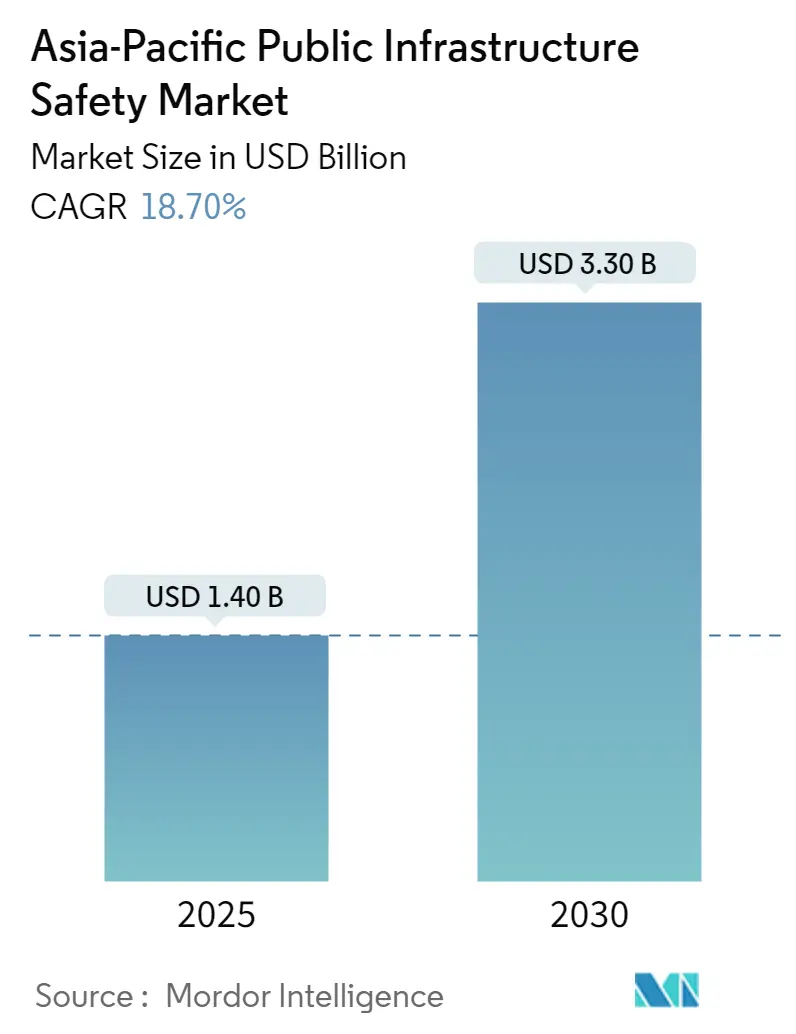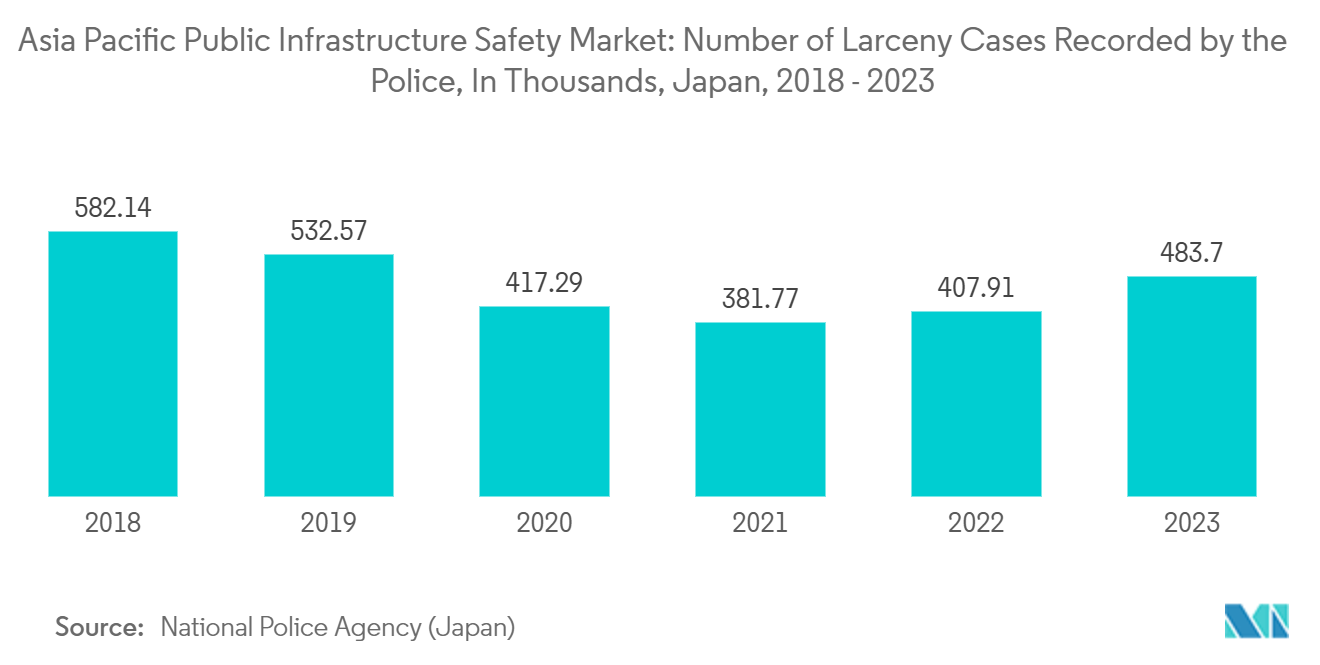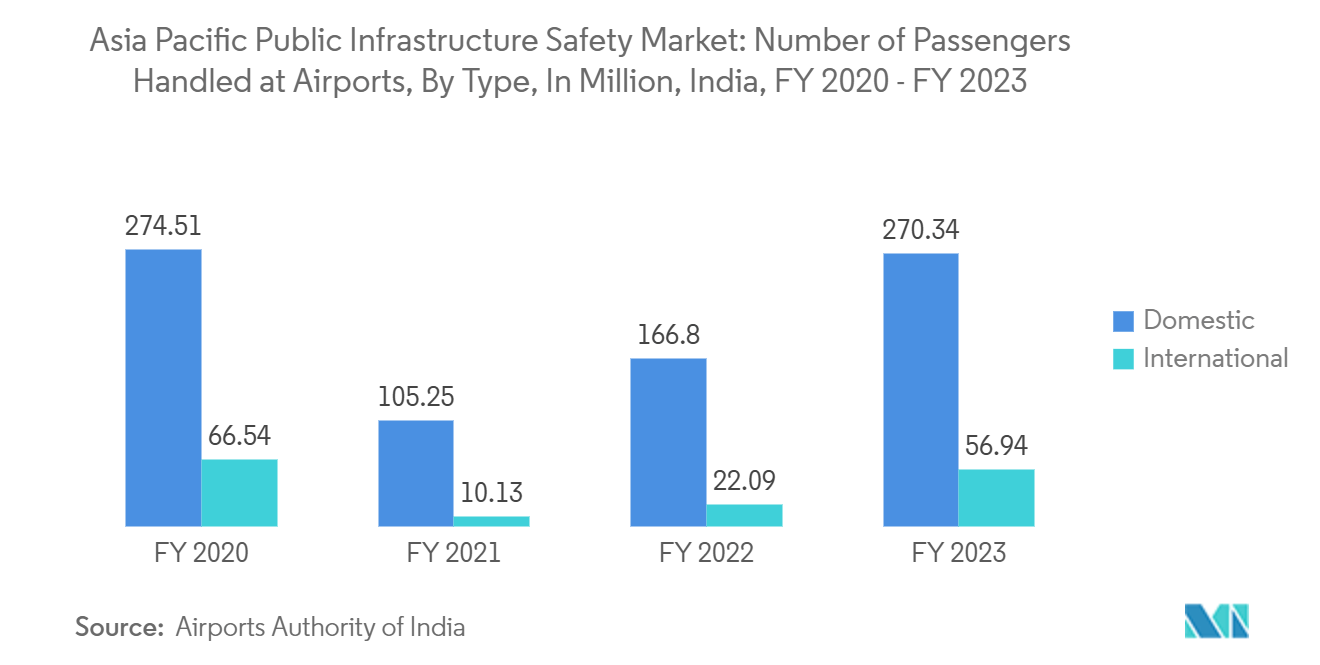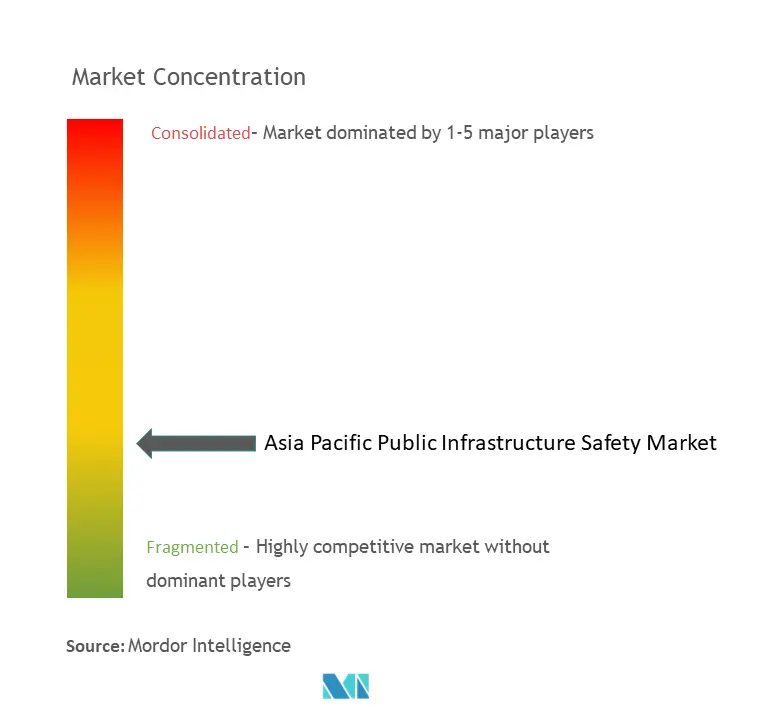Asia-Pacific Public Infrastructure Safety Market Size and Share

Asia-Pacific Public Infrastructure Safety Market Analysis by Mordor Intelligence
The Asia-Pacific Public Infrastructure Safety Market size is estimated at USD 1.40 billion in 2025, and is expected to reach USD 3.30 billion by 2030, at a CAGR of 18.7% during the forecast period (2025-2030).
- The growing crime rate, number of accidents, and terrorist activities, coupled with the increasing investments in smart grid technology, are contributing to the growth of the market studied. Moreover, over the past few years, terrorist activity and crime rates have increased in the region, resulting in heightened concerns about the safety of people, assets, and processes. If left unchecked, these factors may lead to severe damage to infrastructure and the loss of multiple lives.
- Governments across the region are making significant investments. Several commercial offices, buildings, businesses, and residential buildings are using access controls. These systems offer enhanced property security for tenants and staff, who can quickly enter with credentials while denying access to unauthorized individuals.
- The increase in terror attacks raises the demand for public infrastructure safety solutions. Furthermore, governments are investing in physical security solutions to reduce crime rates and protect residents, employees, and assets.
- Several countries in the region are using AI in video surveillance as it provides significant benefits in detecting unusual incidents and generating alerts. Starting with high-quality surveillance cameras, Japan's Security System has expanded into AI to ensure optimal safety and efficiency.
- The high initial investment is a significant hindrance to market growth. Governments are spending on installing surveillance systems, biometric security, critical communication networks, and scanning and screening systems, which incur high installation and maintenance costs.
- Furthermore, the impact of macroeconomic factors such as supply chain disruptions, energy prices, sanctions, trade restrictions, and rising inflation, along with the Russia-Ukraine war, has created a challenging environment for the public infrastructure safety market. While the war presents challenges through supply chain disruptions, economic uncertainty, and increased costs, it also drives a renewed focus on security, resilience, and innovation in public infrastructure safety within the Asia-Pacific region.
Asia-Pacific Public Infrastructure Safety Market Trends and Insights
Physical Security To Hold Significant Market Share
- The growing demand for physical security solutions across countries like China and India is expected to lead to market growth. Significant investments made by the Chinese government, primarily focusing on traffic monitoring and city surveillance, are anticipated to drive market growth. For instance, China has over 700 million surveillance cameras. These cameras check if people are wearing face masks or crossing the road before the green lights for pedestrians are turned on.
- China is heavily investing in infrastructure and smart city projects due to urbanization, which is expected to increase the demand for video surveillance solutions. For instance, the Shanghai district is tripling mass surveillance through facial recognition cameras and increasing computing infrastructure several times to power "the mining of massive data" across files for 50+ million citizens' everyday activities and behavior. The project, which was scheduled for completion in May this year, targets Xuhui's ~1.1 million population, even installing cameras in dozens of residential communities. The Xuhui District is home to the American, French, German, Italian, and Swedish Consulates, Microsoft's Research Asia-Shanghai Labs, and the Microsoft INESA AI Innovation Center. It is also described as a hub for many of China's leading AI researchers, with Huawei and Alibaba offices in the West Bund International AI Tower, twin skyscrapers dedicated to AI.
- Increasing border tensions and militant activities are boosting the demand for advanced technology to fight terrorism and cross-border trespassing activities, propelling governments to invest more in border security. For instance, the Indian army has put up smart fences based on cutting-edge sensor and video surveillance camera technologies to thwart infiltration attempts along the Line of Control.
- The market is anticipated to witness growth due to the region's infrastructure being in a phase of rapid urbanization. The ongoing investments in upgrading the transportation infrastructure in urban areas are increasing the need for security scanning, imaging, and metal detection systems. For instance, Delhi's Indira Gandhi International Airport (IGIA) announced that it had started trials of the full-body scanner at its Terminal 2. The new full-body scanners will use millimeter wave technology to detect metallic and non-metallic objects concealed under the clothes, inside body cavities, or even organs.
- Starting with high-quality video surveillance cameras, Japan's Security System is expanding into AI to ensure optimal safety and efficiency. Using AI in video surveillance can provide significant benefits in detecting unusual incidents and generating alerts, thereby increasing the growth of the physical security market in the country.

India To Be The Fastest Growing Country
- Although the overall crime rate in India in 2023 revealed a marginal decrease of 0.56% compared to the previous year, urban areas continue to have higher crime rates than rural regions, increasing the need for video surveillance cameras in the country. For instance, Hyderabad ranked first among the most surveilled cities in India, with 83.32 cameras per 1,000 inhabitants.
- India is one of the busiest countries in the world in terms of road traffic. About 70% of accidents involved young Indians. According to the World Economic Forum, India universally has the highest number of road fatalities, at 250,000 deaths a year. The installation of public safety systems is anticipated to reduce the number of accidents.
- The World Bank has approved USD 250 million in financing to support the Government of India’s Program for Strengthening Road Safety. The project is expected to help reduce road crash injuries and fatalities through improved road safety management institutional reform. It would also strengthen emergency medical and rehabilitation services for post-crash care.
- The increasing demand for video surveillance systems, biometric systems, security scanning, imaging, and metal detection are some of the potential factors driving the segment's growth. Technological advancements in video surveillance systems, such as ultra-high definition, face detection, and wider range, have led to increased adoption of these systems to enhance remote monitoring and safety of citizens.

Competitive Landscape
The Asia-Pacific public infrastructure safety market is fragmented and consists of several players. Companies in the market continuously try to increase their market presence by introducing new products, expanding their operations, or entering strategic mergers and acquisitions, partnerships, and collaborations. Some of the major players include Cisco Systems Inc., NEC Corporation, and L3Harris Technologies Inc.
- March 2024 - Johnson Controls announced expanding its manufacturing footprint in India by expanding its Pune facility. The plant expansion will allow the company to further develop made-in-India parts and products that support India's growth in digital technologies, contributing to the mission of developing Viksit Bharat.
- January 2024 - Johnson Controls launched its latest offering, the Illustra Standard Gen 3, a video range of security cameras designed and primarily manufactured in India. This move aligns with the Government's Make in India initiative, reflecting the company's commitment to self-sufficiency and its strategic positioning in the global manufacturing landscape.
Asia-Pacific Public Infrastructure Safety Industry Leaders
-
Cisco Systems Inc.
-
NEC Corporation
-
Atos SE
-
Hexagon AB
-
Telefonaktiebolaget LM Ericsson
- *Disclaimer: Major Players sorted in no particular order

Recent Industry Developments
- February 2024: Hong Kong announced the addition of thousands of surveillance cameras on the streets, and it is expected to use facial recognition to track residents' movements. The police commissioner said that plans are underway to install 2,000 additional surveillance cameras in public places to prevent crime and monitor public safety and order.
- January 2024: Japan announced that it would enhance security in areas of central Japan, which was hit by a strong earthquake earlier in the month, where thefts and other crimes increased. This involved the installation of around 1,000 security cameras at locations, including evacuation centers. The police had confirmed a total of 32 criminal cases in Ishikawa Prefecture, including burglaries at evacuated homes and thefts in evacuation centers.
Asia-Pacific Public Infrastructure Safety Market Report Scope
Public infrastructure safety refers to the security of infrastructure and includes all essential systems and facilities that allow the smooth flow of an economy’s day-to-day activities and enhance the people's standard of living. The study tracks the revenue accrued through the sale of various security products by the players in the Asia-Pacific market. The study also tracks the key market parameters, underlying growth influencers, and major vendors operating in the industry, which support the market estimations and growth rates during the forecast period.
The Asia-Pacific public infrastructure safety market is segmented by security type (physical security [screening & scanning and video surveillance], building management systems, and vehicle identification management), deployment type (on-premise and cloud-based), end-user industry (transportation, healthcare, educational, and other end users), and country (China, Japan, India, South Korea, and Rest of Asia Pacific). The market sizes and forecasts are provided in terms of value (USD) for all the segments mentioned above.
| Physical Security | Screening & Scanning |
| Video Surveillance | |
| Building Management Systems | |
| Vehicle Identification Management |
| On-premise |
| Cloud-based |
| Transportation |
| Healthcare |
| Educational |
| Other End Users |
| China |
| Japan |
| India |
| South Korea |
| By Security Type | Physical Security | Screening & Scanning |
| Video Surveillance | ||
| Building Management Systems | ||
| Vehicle Identification Management | ||
| By Deployment Type | On-premise | |
| Cloud-based | ||
| By End-user Industry | Transportation | |
| Healthcare | ||
| Educational | ||
| Other End Users | ||
| By Country*** | China | |
| Japan | ||
| India | ||
| South Korea |
Key Questions Answered in the Report
How big is the Asia-Pacific Public Infrastructure Safety Market?
The Asia-Pacific Public Infrastructure Safety Market size is expected to reach USD 1.40 billion in 2025 and grow at a CAGR of 18.70% to reach USD 3.30 billion by 2030.
What is the current Asia-Pacific Public Infrastructure Safety Market size?
In 2025, the Asia-Pacific Public Infrastructure Safety Market size is expected to reach USD 1.40 billion.
Who are the key players in Asia-Pacific Public Infrastructure Safety Market?
Cisco Systems Inc., NEC Corporation, Atos SE, Hexagon AB and Telefonaktiebolaget LM Ericsson are the major companies operating in the Asia-Pacific Public Infrastructure Safety Market.
What years does this Asia-Pacific Public Infrastructure Safety Market cover, and what was the market size in 2024?
In 2024, the Asia-Pacific Public Infrastructure Safety Market size was estimated at USD 1.14 billion. The report covers the Asia-Pacific Public Infrastructure Safety Market historical market size for years: 2019, 2020, 2021, 2022, 2023 and 2024. The report also forecasts the Asia-Pacific Public Infrastructure Safety Market size for years: 2025, 2026, 2027, 2028, 2029 and 2030.
Page last updated on:
Asia-Pacific Public Infrastructure Safety Market Report
Statistics for the 2025 Asia-Pacific Public Infrastructure Safety market share, size and revenue growth rate, created by Mordor Intelligence™ Industry Reports. Asia-Pacific Public Infrastructure Safety analysis includes a market forecast outlook for 2025 to 2030 and historical overview. Get a sample of this industry analysis as a free report PDF download.



